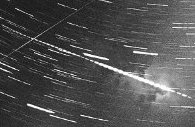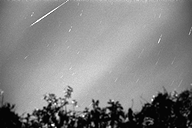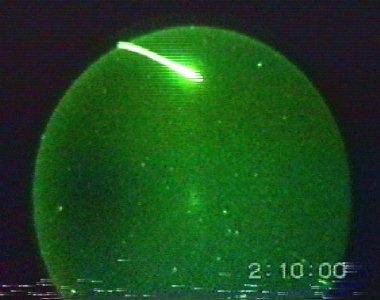We just returned from a very succesful night of watching Lyrid meteors. The shower was quite active and put on a fine show.
The biggest succes of this night (April 21/22) is undoubtedly the brilliant magnitude
-5 Lyrid that appeared at 1:51:30 UT and showed 12 seconds persisting train (visually).
This beautiful fireball was captured >> MULTISTATION << with the image-intensified video cameras of DMS station Leiden and our DMS station Biddinghuizen! Both in the images of Leiden and our images the fireball crosses through the center of the field and almost through the full width of the field. The flares are very brilliant and illuminate some patchy clouds in the fields. The Q-angle between the two stations is very favourable (near 80 degrees). The fireball took almost 1.5 seconds. It is almost certain that both stations captured it with the 50mm Canon photographic camera's of our camera-arrays too, which are equiped with high precision shutters occulting 50 times/second, so we expect to have very good information on the velocity. Undoubtedly, this will become a very high quality orbit after reduction!
We hope to be able to provide the images on our FTP-site soon.
Have a look at our photographic results at the end of this chapter.
The night was highly succesful in other respects too, notwithstanding cirrus-fields in the early part of the night. A short view of the video-tapes at Leiden and Biddinghuizen shows at least half a dozen or more video-Lyrids, most probable multi-station too, a welcome addition because orbits of this stream are still scarce (about 14 worldwide at this moment). Additionally, we captured some nice sporadics and possibly some occasional Lyrids photographically, amongst which a beautiful long -5 sporadic with a very long lasting train around 2:10 UT, and another -3 sporadic an hour later. A -2 Lyrid early in the night might be photographed, though not multistation due to cloudiness at Leiden.
During evening twilight we got a last glimpse of comet Hyakutake. Showing a 5 to 6 degrees tail in binoculairs and on the video-images (and about 2-3 degrees with the naked eye), we estimated the brightness at about +2.7 (Morris-method). The comet seems to have had enough of it and has gone for hollidays, unfortunately....
Here I present some first visual results of our two observational nights at DMS station Biddinghuizen around the annual Lyrid maximum. A report on some nice fireballs (one of them, a -5 Lyrid, recorded multi- station by both photographic and video-equipment) of April 21/22 has been send earlier. At this moment, I am only able to provide my own data, including a preliminary ZHR. ZHR-calculations have been carried out using gamma=1.4 in radiant altitude correction, my usual Cp=1.2 and assuming the regular Lyrid population-index of 2.7.
The results seem to be slightly (but only slightly) above average (the average ZHR for the night of 20/21 (22:45-2:45 UT) is 10.5 +- 2.6, and for the night of 21/22 (21:15-2:00 UT) it is 22.9 +- 3.1). This could be due to the present minimum in solar activity (which influences the higher atmosp- here), or simply be an observer's variation (note that for 21/22 my number of sporadics is a little bit high too). Limiting magnitudes varied a little bit due to streaks of cirrus and small fields of altocumulus. In the field, I judged activity quite similar to 1995, taking into account the more favoura- ble location of Biddinghuizen. As mentioned in an earlier mail, activity was fine and the stream presented us with an attractive show. There was a noticable mu Virginid activity too. The fireballs of 21/22 made the cam- paign even more delightfull. Though the weather was not optimal, we would like to characterize this campaign as succesfull as far as our activi- ties at Biddinghuizen are concerned.
| Observer: Marco Langbroek |
|---|
| Dutch Meteor Society |
| station Biddinghuizen, the Netherlands |
| 52 degrees 27' N, 5 degrees 43' E |
| 1996 April 20/21 | |
|---|---|
| 61 meteors in 3.07h effective time from 22:45 UT to 2:18 UT | |
| 17 | Lyrids |
| 37 | sporadics |
| 4 | mu Virginids |
| 2 | Virginids |
| 1 | alpha Bootid |
| period (UT) | Teff (h) | Lm | Nlyr | Nspo | Nmvir | Nvir | Nboo | ZHR lyr |
|---|---|---|---|---|---|---|---|---|
| 22:45-23:30 | 0.75 | 6.3 | 4 | 11 | 2 | 1 | 0 | 10.7 +- 5.3 |
| 23:30-00:43 | 0.73 | 6.0 | 5 | 6 | 1 | 0 | 0 | 14.5 +- 6.5 |
| 00:43-02:00 | 1.28 | 6.4 | 7 | 16 | 1 | 1 | 1 | 6.3 +- 2.4 |
| Stream | -1 | 0 | 1 | 2 | 3 | 4 | 5 | 6 |
|---|---|---|---|---|---|---|---|---|
| Lyrids | 1 | - | - | 1 | 5 | 5 | 5 | - |
| sporadics | 1 | - | - | 3 | 2 | 15 | 13 | 3 |
| mu Vir | - | 1 | - | - | 1 | 1 | 1 | - |
| Virginids | - | 1 | 1 | - | - | - | - | - |
| alpha Boo | - | - | - | - | - | - | 1 | - |
| 1996 April 21/22 | |
|---|---|
| 132 meteors in 3.55h effective time from 21:15 UT to 2:45 UT | |
| 53 | Lyrids |
| 74 | sporadics |
| 4 | mu Virginids |
| 1 | Virginid |
| period (UT) | Teff (h) | Lm | Nlyr | Nspo | Nmvir | Nvir | ZHR lyr |
|---|---|---|---|---|---|---|---|
| 21:15-22:12 | 0.95 | 6.5 | 7 | 22 | 2 | 1 | 19.5 +- 7.4 |
| 22:12-23:30 | 0.82 | 6.0 | 5 | 15 | 1 | 0 | 17.6 +- 7.9 |
| 00:25-00:38 | 0.22 | 6.4 | 4 | 2 | 0 | 0 | 23.8 +- 11.9 |
| 1:14-2:15 | 0.95 | 6.6 | 21 | 25 | 0 | 0 | 20.1 +- 4.4 |
| 2:15-2:45 | 0.45 | 6.5 | 16 | 10 | 1 | 0 | 33.6 +- 8.4 |
| Stream | -5 | -4 | -3 | -2 | -1 | 0 | 1 | 2 | 3 | 4 | 5 | 6 |
|---|---|---|---|---|---|---|---|---|---|---|---|---|
| Lyrids | 1 | - | - | - | - | 3 | 0 | 6 | 12 | 22 | 8 | 1 |
| sporadics | 1 | - | 1 | - | - | - | 1 | 7 | 11 | 25 | 19 | 9 |
| mu Vir | - | - | - | - | - | - | - | - | - | 3 | 1 | - |
| Virginids | - | - | - | - | - | - | - | - | 1 | - | - | - |
A short note concerning the 'dark meteors' which are currently so popular:
- 20/21 April: N=5 (23:33, 23:36, 23:41, 00:19, 00:50 UT)
- 21/22 April: N=1 (1:22 UT)
None of them came from the Lyrid radiant. Note the dramatic difference between April 20/21 and April 21/22: just the opposite of the 'normal' meteor activity. It might be not a coincidence that on April 20/21 I was actually quite tired and we had forgotten to bring coffee with us. Actually, I cannot recall seeing so many on one single night before! The observed 'dark meteors' were usually mediumfast to fast, only one of them was slow. The hour-angles from which they seemed to appear (i.e. the direction of origin, in a sky division in 12 clock hours similar to the system as used by fighter pilots to denominate directions of incoming 'bandits' to wing mates) are resp.: 3, 10, 11, 8, 5 for April 20/21 and 9 for April 21/22. Usually they appeared, as can be noted, in low angles (i.e. sub-horizontal) to a horizon- tal line across the field of view: this is something I noted before. Hardly never one sees one vertical, either crossing from top to bottom or vice versa. Again, this suggests to me that it is something which has it's origin in our brain-nerve system and are not real celestial objects. Usually they look like small squarish objects with a 'black' or very deep purple colour and they move in straight lines, unlike the 'stars' one can see when looking too sudden to a deep blue sky (or after banging your head against a streetlight because you were looking to that pretty girl passing by).
It might be worth noting that actually the blood-flow in our brain regions is much different when laying (sub-) horizontal as compared to a normal upright posture: the blood switches to a different set of veins and actually begins to flow in an opposite direction (this has to do with the adaptations which made primitive hominids succesfull bipedals: other (current) prima- tes don't have this system)! This might influence bloodflow to the eye's retina and nerve system too. Could this cause these strange penomenon?
 |
 |
 |
|---|---|---|
| Biddinghuizen | Leiden | Benningbroek |
 |
|---|
 |
 |
|---|